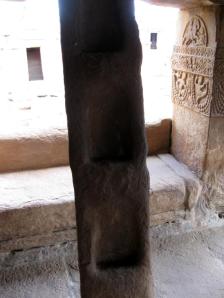
A drive through sleepy hamlets, lush green fields and the village of Aihole (pronounced I-ho-lay), brought us to another heritage temple site dating from around the 5th century.
Known as Aryapura in ancient times, Aihole occupies a unique place in the history of temple architecture in India. It was the site for experimenting with different temple-building styles by the early Chalukyan kings from AD 450 to 750. This experimentation began in Aihole, continued at Badami and finally culminated at Pattadakal. Our guide told us that the ruins of a temple, probably dating back to pre-Chalukyan times, had been recently excavated in Aihole. The present-day village settlement and agricultural lands were coming in the way of a full-scale excavation.
There are around 120 temples of varying styles and sizes in Aihole (all built from the same local red sandstone). I tried to imagine 120 temples, each with a unique architecture and failed. But I could imagine the whole area being turned into an architectural laboratory or a workshop, with architects and sculptors being invited over and given a site for constructing a temple. Just imagining the creative buzz in the area was enough to give me a high! Unfortunately, our group had the time to visit only one site, which had about 4 temples of such varying styles that it was astonishing and gave a glimpse into the kind of experimenting that was promoted and encouraged.
The Durg or Fortress Temple is an extremely photogenic temple and a visitor automatically gravitates towards it. A unique feature of this temple is the curvilinear passage/corridor that runs around the temple.


Though it was evident that we could see that all the temples were built of sandstone, the Ladkhan Temple did raise some doubts. It actually looked like a stone temple with wooden logs placed on its roof; the stone logs looked that realistic ! The Ladkhan Temple is also, probably, the oldest temple in Aihole, dating back to the 5th century.

We also saw a temple with a sloping stone roof, another unique feature. It could have passed off as a one room cottage, and a rather cute cottage at that. Don’t you think so?

In addition to the 3 temples mentioned above, we also saw a temple built in the Dravida Vimana style, dedicated to Surya.

Unlike Pattadakal‘s or Hampi’s monuments, Aihole’s temples are not considered to be a UNESCO World Heritage site. I don’t know if it is logistics that prevents it from being declared as one or if Aihole needs some serious lobbying to get the attention of UNESCO. There is something about Aihole that appealed to me, though I am not sure as to what that is. I am willing to lobby for Aihole’s temples, if it means that they get the deserved attention. Though how I would go about doing it, I have no idea. I just know that it needs to be done.
As we left, I could see some temples further away on hill tops and knew for sure that I was going to come back to Aihole for a detailed tour of all the 120 (and still counting) temples one day.
Soon…
P.S.: This visit was part of a tour organised by Doreen D’Sa of Doe’s Ecotours. She can be contacted at does_ecotours@yahoo.co.in.

AIHOLE temples are so unique in thier style and buildings it was like every creator had his own vision and he designed each one differently, but ultimately there was unity in diversity.
What a pity they are not on world map of UNESCO.
Sudha you brought back the very words of our guide.
It is a pleasure to see your blogs
LikeLike
How beautiful stone can look, after the sculptor works his magic..The Durg and the Ladkhan temples are so lovely in the pictures, how they must have looked in real life. The pictures and the text together, are treat for the senses. Never thought history could be so engaging.
LikeLike
wonderful images too!
LikeLike